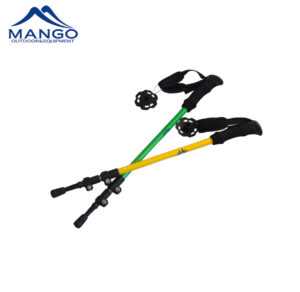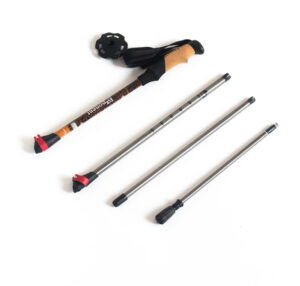Trekking poles are essential equipment for hikers, backpackers, and outdoor enthusiasts, providing stability and support on various terrains. To maximize their effectiveness and comfort, it’s crucial to choose trekking poles of the correct height. In this guide, we will walk you through the process of determining the right height for your trekking poles, ensuring you have a more enjoyable and safe hiking experience.
Why Trekking Pole Height Matters
The height of your trekking poles has a significant impact on your overall hiking experience. Properly sized poles can:
Reduce Strain: Adjusting your poles to the correct height helps distribute your weight more evenly, reducing strain on your joints and muscles.
Enhance Balance: Well-fitted trekking poles provide better balance, especially when navigating uneven terrain or stream crossings.
Improve Posture: The right pole height encourages better posture, which can prevent back pain and discomfort on longer hikes.
How to Determine the Right Height?
Follow these steps to find the ideal height for your trekking poles:
Stand Upright: While wearing your hiking shoes, stand in an upright position on a level surface.
Hold the Poles: Hold the trekking poles with your arms by your sides, ensuring the poles are vertical and touching the ground.
Adjust the Length: Most trekking poles have an adjustable feature to change their length. Begin by adjusting the poles to a length where your elbows form a 90-degree angle when you hold the grips. This is a good starting point.
Test on the Trail: Take your poles out on a trail and hike for a while. Pay attention to how they feel. If you find yourself leaning forward or using the poles with your arms at an acute angle, you may need to adjust the length.
Fine-Tune the Height: To fine-tune the height, make small adjustments until you find the most comfortable setting. Keep in mind that the ideal height may vary based on the terrain and your personal preferences.
Factors to Consider
When determining the height of your trekking poles, consider the following factors:
Terrain: If you frequently hike on steep or uneven terrain, you may prefer shorter poles for better control. Longer poles are more suitable for flatter terrain.
Backpack Weight: If you carry a heavy backpack, longer poles can provide additional support. Adjust the height to accommodate the added load.
Personal Preference: Ultimately, the right height is what feels most comfortable for you. Experiment with different lengths to find your preferred setting.
FAQs About Trekking Pole Height
Here are some common questions about selecting the right height for trekking poles:
Q1: Can I use a fixed-length trekking pole if I can’t find an adjustable one of the right height?
A1: Fixed-length poles can work if you find a model that matches your ideal height. However, adjustable poles offer greater versatility for different terrains and preferences.
Q2: Do I need to adjust my trekking pole height when going downhill or uphill?
A2: Yes, it’s a good practice to adjust the pole height based on the terrain. Shorter poles are generally more suitable for uphill hikes, while longer poles provide better support when descending.
Q3: What if I’m in between standard pole lengths?
A3: If you find yourself between standard lengths, opt for the longer size and make slight adjustments as needed.
Choosing the right height for your trekking poles is a crucial step in preparing for a safe and comfortable hiking adventure. By following these guidelines and considering your unique needs, you can select the perfect trekking poles that will enhance your outdoor experiences and help you conquer various trails with confidence.
If you are looking for a trusted supplier of high-quality trekking poles, please do not hesitate to contact us.


